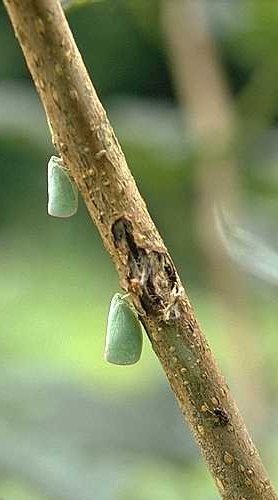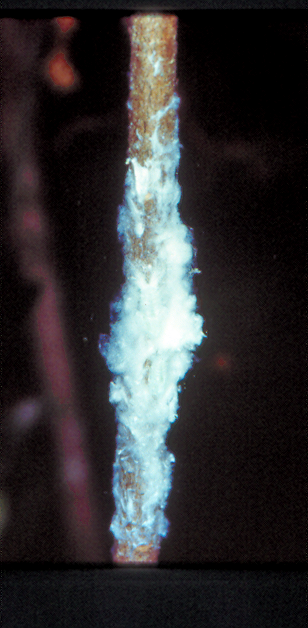Vignettes on Summer Insects
Russell F. Mizell, III, Professor of Entomology, NFREC-Quincy
Planthoppers
Mid-summer is upon us and the usual calls and emails are coming in with “What’s this bug?” Usually it is a flatid planthopper (pale green adult picture) and most of the time it is Metcalfa pruinosa. These are native insects that feed on plant sap and do very little damage. The nymphs (white fuzzy object on plant) are often gregarious or at least clumped on stems where they cover themselves and the stems for protection with copious supplies of a waxy, stringy white substance. They also sport waxy setae that form a tail-like structure. When they are disturbed they jump from the plant to escape.
Citrus psyllids
Everyone in the state should now be aware of the dire disease – citrus greening- threatening citrus production in the U.S and around the world. The causal agent of greening is a bacteria that is spread (vectored) by the Asian citrus psyllid. The psyllid is a small insect ~3-4mm long and gray in color. Producers of satsumas in north Florida are concerned about whether the psyllid or the bacteria is present. The psyllid is a tropical insect and is unable to survive colder temperatures. To date, based on trapping completed since early spring in Gainesville, Live Oak, Quincy and Jackson County, there are no known infestations of citrus psyllids north of Gainesville. Moreover, citrus psyllids from Gainesville that have been genetically analyzed for the greening bacteria have all been negative. Given that no citrus psyllids have been trapped or observed by this time of year, it is unlikely that active infestations exist. That means that producers and homeowners should be very careful to only purchase new plants that have been grown under the state regulatory quarantine procedures. If citrus psyllids do show up later this year, their source will likely be traced to a person bringing them in with new plants, as opposed to either immigration from Central Florida or a resident population.
Bermudagrass stem maggot
Populations of this invasive grass-infesting fly have been on the rise around the Suwannee Valley area and south but have yet to show up in high populations further north. This is based on field sampling this week in Jackson and surrounding counties. We expect that they should be detected any day now, so stay alert to the problem. However, army worms are a different story and are widely apparent in high populations around North Florida hay fields and pastures.
- Apopka WeevilConfirmed in Jefferson County Nursery - September 14, 2018
- Potential Pests and Diseases of Olives in Florida - October 14, 2016
- Plant Recommendations to Augment Ecosystems Services - February 12, 2016


